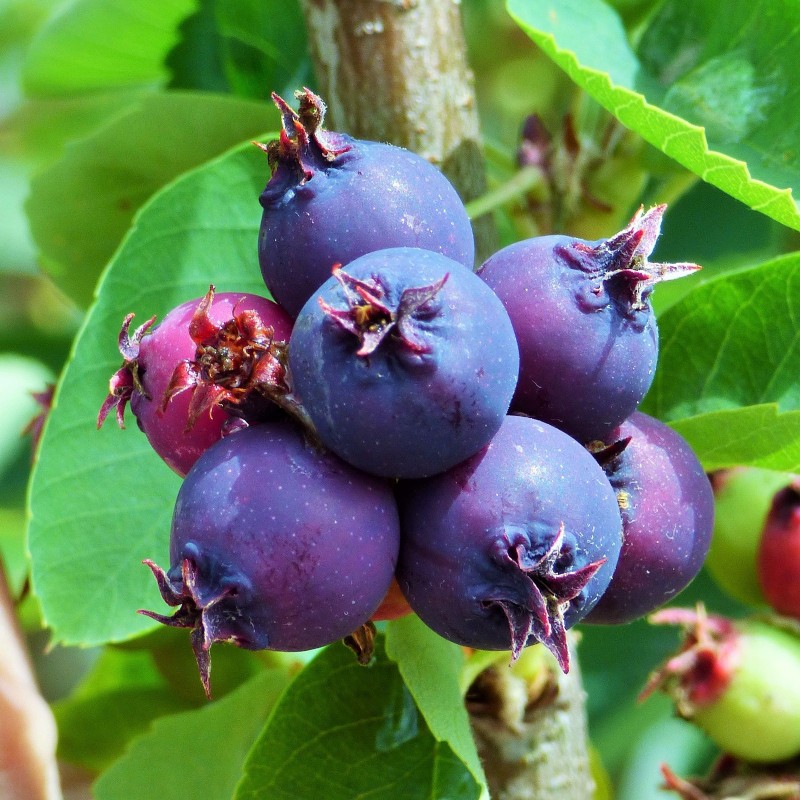
Plant resistant to cold and frost







Saskatoon Serviceberry each year announces their presence in the early springtime when the slender pinkish buds turn to 1-inch white flowers blooming so profusely that the branches are obscured by their feathery petals. The blooms are reminiscent of the witch hazel. Deciduous, ranging in height to 35 feet and up to 20 feet wide, the Saskatoon Serviceberry begins its annual growth cycle with these flowers even before the leaves sprout in their shades of silver or red which turn to green.
The leaves are downy when they are young and similar to those of cherry cultivars. The mature leaf color is dark green or even a slightly blue tint on top, not glossy, and pale on the underside. They are thicker and more firm in texture than the cherry leaves.
After the blooms fade the fruits appear in the latter part of June or early July, hence another of its common names, the Juneberry. These plentiful red-purple fruits are sweet and juicy, soft in texture, and often said to be similar in taste to apples. This is quite natural, as they are a member of the apple family. The fruits are about 1/4 to 1/2 inch in diameter with 2 to 5 very small seeds in the pear or apple-like core. They resemble high bush blueberries in size and shape, but they are not related to the blueberry.
One would think the lovely blooms and delicious fruit would be enough of a gift from these trees, but in autumn the oval or oblong-shaped leaves, 2 to 5 inches long and 1 to 2 inches wide, turn to wondrous shades of yellow-orange to reddish-purple before they fall to carpet the ground beneath.
In winter the overall rounded shape of the branches is pleasing to the eye with their gray to black coloration until the new red-brown twigs start the cycle anew come spring. The bark itself is interesting, tightly holding the trunk(s) and branches, it has very distinctive vertical lines. It becomes more scaly as the tree matures.
Uses: A wonderful landscape plant, the flowers, foliage, and bark are attractive year-round. Not invasive, the Serviceberry can be planted without fear in beds with other shrubs or trees or as specimen plants. Very resistant to air pollution, they can be grown with a single trunk or multiple trunked groves. They make an excellent windbreak when planted fairly close together so the branches can intertwine to form a living fence.
Economically the wood of the Serviceberry is occasionally made into tool handles, but its most common contribution to humans and wildlife is the delicious berries.
Berries: Sweet in taste, the fruits have long been eaten by Canada's Aboriginal people as pemmican, a preparation of dried meat to which Saskatoon berries are added as flavor and preservative. They are also often used in pies, jams, wines, cider, beers, and sugar-infused berries similar to dried cranberries are used for cereals, trail mix and snack foods, Nutritional.
Other Names: Saskatoon Serviceberry, Western Serviceberry, Shadbush, Shadblow, Indian pear, Juneberry, May cherry
Zone: 3 to 10
Growth Rate: Medium
Plant Type: Deciduous small tree or large shrub
Family: Rosaceae
Native Range: Northwestern North America
Height: 6 to 35 feet
Spread: 3 to 20 feet
Shape: Rounded
Bloom Time: April
Bloom Color: White
Flower/Fruit: Small, 5-petaled, showy, slightly fragrant, white flowers in clusters in early spring, followed by small, roundish, green berries which mature to a dark purple in early summer. Edible berries
Sun: Full Sun to Part Shade
Fall Color: yellow-orange to reddish-purple
Drought Tolerance: Moderate
Site Requirements /Soil Tolerances: Easily grown in average, medium, well-drained soil in full sun to part shade. Tolerant of a somewhat wide range of soils, but prefers moist, well-drained loams.
Uses: Attractive shrub borders as a hedge or screen/windbreak, open woodland gardens or rock gardens. Good plant for bird gardens. Bonsai.
For best results, please follow the instructions in the order provided.
Scarify: Soak in water 24 Hours
Stratify Cold 90 days, 40 Degrees F in a Moist Medium.
Germination: Sow 1/8” Deep
For more information about seed pretreatment and growing trees and shrubs from seed, please download this .pdf:
https://www.forestresearch.gov.uk/documents/1449/fcpg018.pdf
Data sheet

 Reviews (0)
Reviews (0)